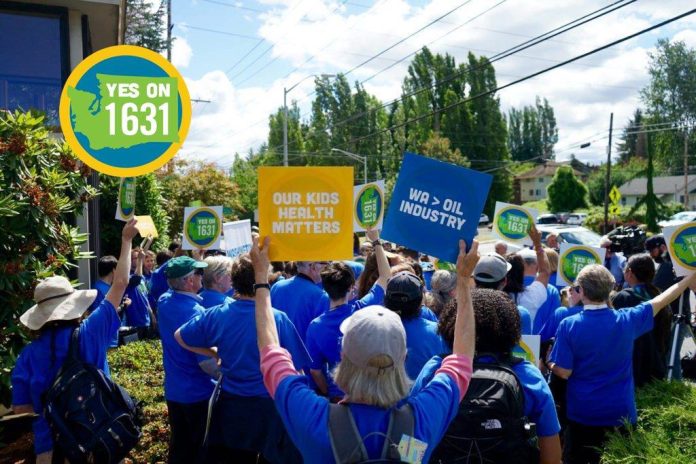We have an enormous opportunity. Washington state could do something really meaningful to address climate change by passing a ballot initiative pricing carbon. I-1631 has united a broad coalition around a carbon pollution fee that then funds the green economy.
On October 10th, supporters are gathering at Optimism Brewing in Capitol Hill from 5:30 to 7:00pm to discuss the campaign and how we can help push it over the finish line. The Sierra Club, Seattle Transit Riders Union, Seattle Subway, Transportation Choices Coalition, and The Urbanist sponsored the event–and SPOILER ALERT: The Urbanist Election Board voted to endorse I-1631 because let’s not torch the planets, guys.
“Washington’s clean air, clean energy, carbon-neutral future is up to us. This groundbreaking initiative will put our state in the forefront of the fight against climate change and for environmental justice,” the event invite states. “Come learn how you can be part of the action!”
Taking on Big Oil
You’ve probably seen the advertisements urging you to vote no on I-1631 paid for by the petroleum industry. In fact, the fossil fuel industry has poured $20 million (and counting) into defeating I-1631.
We’re not going to be able to out-raise the most profitable industry in the history of the planet and they’re not going to willingly stop doing what made them filthy rich. The petroleum industry has staked claims to oil and gas reserves amounting to at least five times what we can burn without cooking the planet (exceeding a 2 degree Celsius increase which means a -high probability of melting ice caps and drowning coastal cities around the globe.) That’s why we need a powerful grassroots movement to counteract that dirty money.
Tackling a problem as mammoth as climate change requires bold action and the willingness to question the ways we done things for decades. Nibbling around the edges with electric cars and efficient lights and buildings is not enough. We must price carbon so oil companies (and individuals) cannot treat the atmosphere as their unmitigated dumping zone.
Carbon Fees Fund Transit, TOD, Forestry and Clean Energy
Under the initiative, large carbon emitters would be charged a $15 per ton fee starting in 2020. The amount would be adjusted for inflation annually and increase by $2 annually “until the state’s existing greenhouse gas reduction goal for 2035 is met and the state is on pace and likely to meet the 2050 greenhouse gas reduction goal.”
Crucially, I-1631 would invest in transit, affordable transit-oriented housing, clean energy, and carbon sequestration through forestry and agriculture–all things to put us on a more sustainable path going forward. These investments should also make for better cities.
“The initiative is estimated to raise about $1 billion in its first year with revenues going toward three key program areas: 70% for the Clean Air and Clean Energy Investments Program, 25% for the Clean Water and Healthy Forests Investments Program, and 5% for the Healthy Communities Investments Program,” Stephen Fesler wrote in his I-1631 primer.
The Clean Air and Clean Energy Investments Program would include “transportation investments in public transit, non-motorized transportation, affordable transit-oriented development, rural broadband to facilitate telecommuting, transportation demand management strategies, and other ways to reduce vehicle miles traveled.”
The transportation sector accounts for two-thirds of carbon emissions in the Puget Sound Region. That’s why it’s great to see a plan that would help rectify that problem. Transit is the way of the future–at least if you don’t want a burning planet.
Doug Trumm is publisher of The Urbanist. An Urbanist writer since 2015, he dreams of pedestrian streets, bus lanes, and a mass-timber building spree to end our housing crisis. He graduated from the Evans School of Public Policy and Governance at the University of Washington in 2019. He lives in Seattle's Fremont neighborhood and loves to explore the city by foot and by bike.


